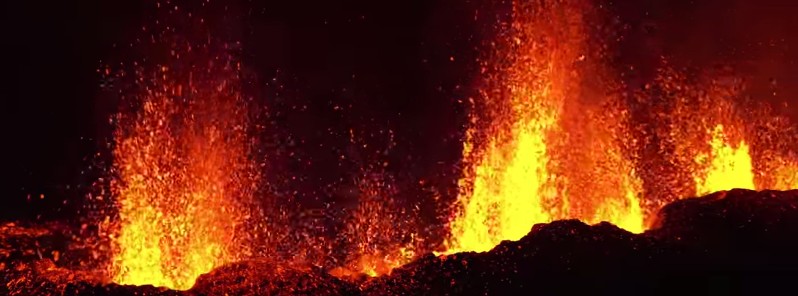Eruption continues at Piton de la Fournaise, Reunion

A new eruption that started at Reunion's Piton de la Fournaise volcano on July 14, 2017 continues for the third day in a row.
By 15:00 UTC on July 15, the tremor has decreased by a factor of 7 compared to the beginning of the eruption and has remained constant since 06:00 UTC, OVPF reports.
This decline was reflected on the field by a decrease in the lava output and the distribution of activity on the eruptive fissure. In comparison with the 7 lava fountains observed on July 14th, there were only 3 lava fountains on July 15, with a maximum height of 30 meters (98 feet), which were active on the lowest part of the eruptive fissure. They began to form two small volcanic cones, which later merged into a single channel. The lava front was about 2.2 km (1.3 miles) ESE of the eruptive site.
After a new phase of increase during the night of July 16 – 17, the intensity of the tremor decreased on July 17th between 03:00 and 09:00 UTC before again experiencing phases of significant fluctuations.
These variations are often observed during the first days of an eruption and correspond to the building of the eruptive cone at a single point.
This eruptive cone undergoes phases of construction and collapse which modify its morphology and the pressure at its center, which accounts for these variations of the tremor.
Piton de la Fournaise eruption – July 14 – 17, 2017
Geological summary
The massive Piton de la Fournaise basaltic shield volcano on the French island of Réunion in the western Indian Ocean is one of the world's most active volcanoes. Much of its more than 530 000-year history overlapped with eruptions of the deeply dissected Piton des Neiges shield volcano to the NW. Three calderas formed at about 250 000, 65 000, and less than 5 000 years ago by progressive eastward slumping of the volcano. Numerous pyroclastic cones dot the floor of the calderas and their outer flanks.
Most historical eruptions have originated from the summit and flanks of Dolomieu, a 400-m-high (1 312 feet) lava shield that has grown within the youngest caldera, which is 8 km (26 247 feet) wide and breached to below sea level on the eastern side. More than 150 eruptions, most of which have produced fluid basaltic lava flows, have occurred since the 17th century. Only six eruptions, in 1708, 1774, 1776, 1800, 1977, and 1986, have originated from fissures on the outer flanks of the caldera. The Piton de la Fournaise Volcano Observatory, one of several operated by the Institut de Physique du Globe de Paris (IPGP), monitors this very active volcano. (GVP)
Data source: OVPF. Translation by Claude Grandpey
Featured image: Eruption of Piton de la Fournaise on July 14, 2017. Credit: Reunion en Ler (You Tube video screenshot)

Commenting rules and guidelines
We value the thoughts and opinions of our readers and welcome healthy discussions on our website. In order to maintain a respectful and positive community, we ask that all commenters follow these rules.